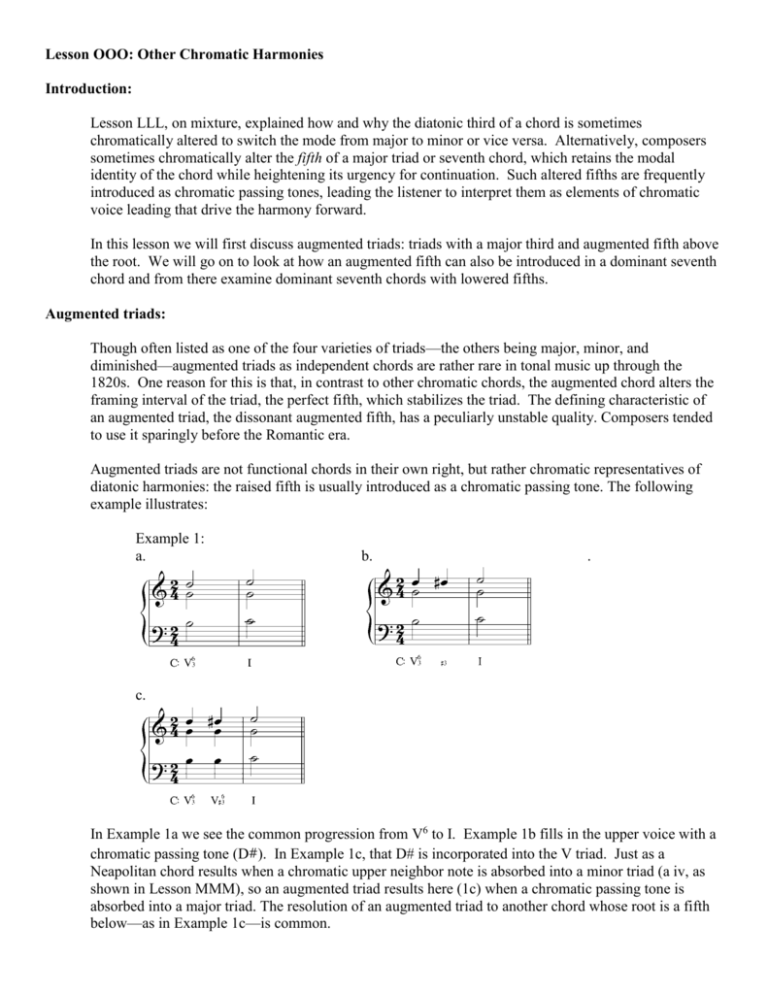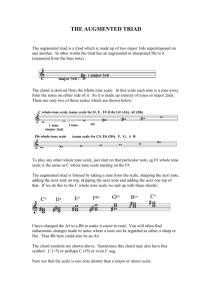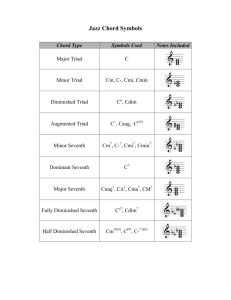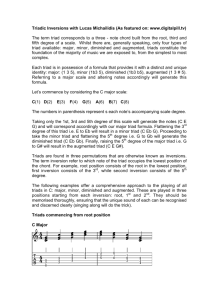Example 1 (Beethoven Bagatelle in C major Op 119 No 8 mm 1
advertisement

Lesson OOO: Other Chromatic Harmonies Introduction: Lesson LLL, on mixture, explained how and why the diatonic third of a chord is sometimes chromatically altered to switch the mode from major to minor or vice versa. Alternatively, composers sometimes chromatically alter the fifth of a major triad or seventh chord, which retains the modal identity of the chord while heightening its urgency for continuation. Such altered fifths are frequently introduced as chromatic passing tones, leading the listener to interpret them as elements of chromatic voice leading that drive the harmony forward. In this lesson we will first discuss augmented triads: triads with a major third and augmented fifth above the root. We will go on to look at how an augmented fifth can also be introduced in a dominant seventh chord and from there examine dominant seventh chords with lowered fifths. Augmented triads: Though often listed as one of the four varieties of triads—the others being major, minor, and diminished—augmented triads as independent chords are rather rare in tonal music up through the 1820s. One reason for this is that, in contrast to other chromatic chords, the augmented chord alters the framing interval of the triad, the perfect fifth, which stabilizes the triad. The defining characteristic of an augmented triad, the dissonant augmented fifth, has a peculiarly unstable quality. Composers tended to use it sparingly before the Romantic era. Augmented triads are not functional chords in their own right, but rather chromatic representatives of diatonic harmonies: the raised fifth is usually introduced as a chromatic passing tone. The following example illustrates: Example 1: a. b. . c. In Example 1a we see the common progression from V6 to I. Example 1b fills in the upper voice with a chromatic passing tone (D#). In Example 1c, that D# is incorporated into the V triad. Just as a Neapolitan chord results when a chromatic upper neighbor note is absorbed into a minor triad (a iv, as shown in Lesson MMM), so an augmented triad results here (1c) when a chromatic passing tone is absorbed into a major triad. The resolution of an augmented triad to another chord whose root is a fifth below—as in Example 1c—is common. In Example 1, the augmented quality is indicated by the accidental in the figured bass (V # 36 ). Augmented triads are sometimes indicated by a superscript plus sign: V – V+ – I. Now consider the following example: Example 2 (L. Beethoven, Piano Sonata No. 5 in C minor, Op. 10, mm. 78-82): In this example, the fifth of a tonic triad (Eb) leads to a chromatic passing tone (E natural) on its way to F, creating an augmented triad with the other voices. It might at first seem appropriate to label such a chord “I # 36 .” But you’ll notice in Example 2 that the chord on the second beat of m. 79 is labeled “V # 36 /IV.” The integration of the chromatic passing tone undermines the identity of the tonic, a place of stability and repose. The E natural—now functioning as a leading tone to F—activates harmonic motion and drives the altered tonic to the subdominant. In other words, Ab, C, E-natural no longer functions as tonic but rather strives towards IV in the manner of an applied dominant. For this reason, we have labeled the sonority as an applied dominant. The following example from Schumann’s Album for the Young has two augmented triads in close proximity: Example 3 (R. Schumann, “Kleine Studie,” No. 14 from Album for the Young, mm. 5-17): In mm. 5-7 we see the progression already familiar from Example 2. Then, following a brief tonicization of ii in mm. 9-13, a similar procedure is applied to a V chord. In m. 16 the seventh from the preceding V7 chord is omitted while the fifth is raised to A#. Just as in Example 1, the raised fifth acts as a chromatic passing tone to B as the chord resolves to I, with root a fifth below. Now consider the following example: Example 4 (L. Beethoven, Bagatelle No. 8 in C major, Op. 119, mm. 1-3): Here we find two augmented applied dominants in a row. In m. 1, the G in the upper voice steps up to G# on its way to A. Then, in m. 2, that A steps up to A# on its way to B while the bass moves to F# and the middle voice to D. As with Example 2, the augmented chord in m. 1 might have been analyzed as an augmented tonic triad. The presence of G#, however, undermines the identity of the chord as tonic and activates a brief tonicization of IV. Analyzing the chord as an applied dominant also brings out the parallelism with the second measure. Regardless, the entire passage should be understood as a chromatic filling in of the common 5 – 6 – 7 motion in the upper voice: Example 5 (reduction of L. Beethoven, Bagatelle No. 8 in C major, Op. 119, mm. 1-3): Activity OOO.01: In each of the following exercises create an augmented triad by raising the fifth of the initial chord. Exercise OOO.01a: Raise the fifth of the V6 chord in G major to create an augmented triad on the second beat of the first measure: [Answer: the middle voice A should be raised to A# on the second beat. Response if correct: “Correct!” Response if incorrect: “Incorrect. Try again.”] [Follow-up question:] What Roman numeral should appear under the altered chord? [Answer: V # 36 or V+6. Response if correct: “Correct!” Response if incorrect: “Incorrect. Try again.”] Exercise OOO.01b: Raise the fifth of the I6 chord in D major to create an augmented triad on the second beat of the first measure: [Answer: the middle voice A should be raised to A# on the second beat. Response if correct: “Correct!” Response if incorrect: “Incorrect. Try again.”] [Follow-up question:] What Roman numeral should appear under the altered chord? [Answer: V # 36 /IV or V+6/IV. Response if correct: “Correct!” Response if incorrect: “Incorrect. (Hint: Tonic triads resolving by root motion of a falling fifth in which the fifth has been raised should be interpreted as applied dominants.)”] Exercise OOO.01c: Raise the fifth of the V6 chord in F major to create an augmented triad on the second beat of the first measure: [Answer: the upper voice G should be raised to G# on the second beat. Response if correct: “Correct!” Response if incorrect: “Incorrect. Try again.”] [Follow-up question:] What Roman numeral should appear under the altered chord? [Answer: V # 36 or V+6. Response if correct: “Correct!” Response if incorrect: “Incorrect. Try again.”] Exercise OOO.01d: Raise the fifth of the I6 chord in Bb major to create an augmented triad on the second beat of the first measure: [Answer: the upper voice F should be raised to F# on the second beat. Response if correct: “Correct!” Response if incorrect: “Incorrect. Try again.”] [Follow-up question:] What Roman numeral should appear under the altered chord? [Answer: V # 36 /IV or V+6/IV. Response if correct: “Correct!” Response if incorrect: “Incorrect. (Hint: Tonic triads resolving by root motion of a falling fifth in which the fifth has been raised should be interpreted as applied dominants.)”] Augmented triads also appear as auxiliary sonorities. In the following example from a song by Hugo Wolf, a tonic triad is prolonged with a chord resembling an augmented dominant triad in first inversion. Example 6 (H. Wolf, “Das verlassene Mäglein” from Mörike-Lieder, mm. 27-29): The augmented triad is presented all at once here: the augmented fifth has been absorbed into the chord and is not introduced here as a chromatic passing tone. This dissonant chord lends an aurally striking quality to this prolongation of I in a way that a diatonic auxiliary sonority could not. The following example shows another augmented auxiliary sonority, though here arising in a different manner. Example 7 (F. Schubert, “Der Atlas,” No. 8 from Schwanengesang, D. 957, mm. 1-4): Whereas in previous examples the chromatic pitch of an augmented triad was introduced as an ascending chromatic passing tone from the fifth of a major reference sonority, here it appears as a chromatic lower neighbor to the root of a minor triad. (Note: Normal figured bass conventions are incapable of showing this alteration since the chromatic pitch appears in the bass. The parenthetical “(#5)” under the Roman numeral indicates the raised fifth.) The result, in this case, is a neighboring auxiliary sonority that resembles a III chord with a raised fifth in second inversion. Note: In the lesson on the minor scale (Lesson 03), it was mentioned that the ubiquitous raised leading tone of minor keys does not apply to chords built on scale degree 3. As Example 7 shows, the presence of #7 in a III chord creates an augmented fifth with the root. The triad built on scale degree 3 is the tonic of the relative major. Having an augmented triad here would subvert this important relationship and is therefore not permitted. Unlike, say, V6, which can serve as either a functional dominant or an auxiliary sonority, the parenthetical chords in Example 7 can never stand on their own as independent harmonies. That said, you may occasionally encounter other sources that treat III#5 as a rare but normal chord. We disagree with that view for the reasons listed above and hold that the diatonic mediant chord is major in a minor key. With the increasingly adventurous chromaticism of the nineteenth century, the treatment of augmented triads slowly relaxed. Rather than simply serving as chromatic representatives of diatonic harmonies, augmented triads began taking on more structural roles. Consider the key structure of the following excerpt from a Chopin etude, composed around 1840: Example 8 (F. Chopin, posthumous Etude No. 2, mm. 1-30): In tonal music, it is quite normal for a piece to progress through the keys outlined by the tonic triad. A piece in A minor, for example, might begin in A minor and modulate to C major (the relative major) and then E minor (the minor dominant) before returning to A. In this case, however, the keys cycle through an augmented triad: Ab – E (in m. 17) – C (m. 20) – Ab (m. 25). Note also the use of augmented triads in the last half of mm. 25, 26, 27, and 28. In each case, the augmented triad, respelled enharmonically, functions as an applied dominant to the first chord in the next measure. Ab-C-E-natural at the end of m. 25, for example, respells as E-G#-B#, which is a V#5 of the following A-major chord. The progression across the bar lines of the next three measures operate similarly. Despite this chromatic motion, Ab major remains as the overriding key here. The A-, Bb-, and B-major triads—shown in square brackets and indicated with hyphens in the main Ab major line of analysis—function as passing chords, filling in the space between the Ab-major chord in m. 25 and the C-minor chord that ends the pattern in m. 29. Activity OOO.02: As you can see from Example 8 (reproduced below), another augmented triad appears at the end of m. 27, continuing the pattern from the previous two measures. The chord is notated: Bb, Dnatural, F# but resolves like a V#5 to a B major triad in m. 28. How could this chord be respelled to reflect its function as V#5 in B major? (In other words, what three pitches comprise V#5 in B major?) [Answer: F#, A#, Cx. Response if correct: “Correct!” Response if partially correct: “That is partially correct. Remember, all three pitches must be enharmonic respellings of the notes already present.) Response if incorrect: “Incorrect. (Hint: If F# is the root of this chord, what other pitches must appear to complete the augmented triad?)”] Altered dominant seventh chords: Dominant seventh chords occasionally appear in an altered form, with a raised or lowered fifth. Since dominant sevenths have a major third above the root, raising the fifth will result in an augmented triad with a minor seventh. Like the augmented triads discussed above, the augmented fifth is typically introduced as an ascending chromatic passing tone: Example 9 (J. Brahms, Intermezzo No. 7 in A Minor, Op. 76, mm. 12-16): At the end of m. 15 in this example from Brahms, the fifth of the dominant seventh chord (D) is raised one semitone to D#. The resultant V # 57 consists of an augmented triad (G, B, D#) with a minor seventh above the root (F). This chord resolves very similarly to the augmented triads mentioned above in Examples 1 through 6: the augmented fifth resolves upward by semitone to the third of the chord whose root is a fifth below. Applied dominant sevenths also appear with raised fifths: Example 10 (piano reduction of R. Strauss, Till Eulenspiegel’s Merry Pranks, Op. 28, mm. 1-3): Scale degree 5 steps up to C# at the end of m. 1 in example above. Because of its rhythmic placement—occurring with the Eb, A and Fs of the bass and inner voices—we hear C# as belonging to the chord on the final eighth note. The chord, an applied dominant seventh with raised fifth, resolves to IV on the downbeat of the following measure. Again, the chromatic pitch is accentuated by its placement in the soprano and root motion of the resolution is a falling fifth. Activity OOO.03: The following excerpt (J. Brahms, “Wie Melodien zieht es Mir,” Op. 105, No. 1, mm. 7-12) contains two chords with raised fifths, one in m. 8 and one in mm. 9-10. Exercise OOO.03a Ignoring, for the moment, the raised fifth, what Roman numeral should appear under mm. 9-10? [Answer: V. Response if correct: “Correct!” Response if incorrect: “Incorrect. (Hint: The chord is in root position.)”] [Follow-up question:] Identify the raised fifth of the dominant chord in mm. 9-10. [Answer: any of the three B#s in mm. 9-10. Response if correct: “Correct!” Response if incorrect: “Incorrect. (Hint: First identify the root of the chord, then determine which voice or voices are sounding an augmented fifth above the root.)”] Exercise OOO.03b Ignoring, for the moment, the raised fifth, what Roman numeral should appear under m. 8? [Answer: V7/V. Response if correct: “Correct!” Response if incorrect: “Incorrect. (Hint: The D# on the downbeat of this measure indicates that this is not a diatonic chord in A major.)”] [Follow-up question:] Identify the raised fifth of the applied dominant seventh chord in m. 8. [Answer: either Fx on the second half of beat four. Response if correct: “Correct!” Response if incorrect: “Incorrect. (Hint: First identify the root of the chord, then determine which voice or voices are sounding an augmented fifth above the root.)”] Dominant seventh chords with lowered fifths (b2 instead of 2) recall the characteristic sound of the Phrygian mode, which features a semitone between its first and second degrees. Consider the following excerpt from Grieg: Example 11 (E. Grieg, Lyric Piece, Op. 47, No. 3, mm. 37-42): As you can see from Example 13, the fifth of the V 34 chord in m. 39 steps down to Bb in the following measure. Bb resolves by semitone down to 1. This motion, combined with the leading tone approaching the tonic from below, bears significant resemblance to the resolution of an augmented sixth chord. In an augmented sixth chord, the arrival of the dominant chord is emphasized by the dual “leading tones” #4 and b6 resolving to 5. (See Lesson NNN for more on augmented sixths.) Here, the dual semitone motion leads from b2 and (#)7 to 1. As it turns out, the structure of a dominant seventh chord with a lowered fifth is enharmonically identical to French augmented sixth: Example 12: The first half of Example 12 provides a simplified version of the progression in mm. 40-41 of Example 11. As you can see and hear, the voiceleading is the same as the resolution of a French sixth to a dominant triad. Dominant seventh chords with lowered fifths usually appear in second inversion, highlighting the semitone motion from b2 to 1 by placing it in the bass. The following reduction of Brahms’ fourth symphony shows a dramatic dominant seventh with lowered fifth in m. 7: Example 13 (piano reduction of J. Brahms, Symphony No. 4, Mvt. IV, mm. 1-9): The V 34 chord in m. 7 contains a lowered fifth (F natural, b2). In this case, the lowered fifth is introduced immediately and not as a chromatic passing tone in the bass. Like Example 11, the chord behaves like a French augmented sixth resolving to I instead of V. (Note: The chord of resolution here, the tonic triad in m. 8, contains a Picardy third.) The conclusion of Schubert’s String Quintet (D. 956) provides a particularly dramatic dominant seventh with lowered fifth: Example 14 (F. Schubert, String Quintet in C major, D.956, mm. 400-405): In Example 14 the lowered fifth (Db) of the final dominant harmony appears as a chromatic upper neighbor to 1. The altered chord is preceded by a dramatic ascending scale and arpeggiation in m. 400 and is then sustained for a full two bars before resolving to the final tonic in m. 403. The effect is striking, making this a particularly poignant example of the dramatic capabilities of an altered dominant seventh chord. Now consider the following example: Example 15 (F. Chopin, Nocturne in C# minor, Op. 27, no. 1, mm. 11-18): In this Chopin Nocturne, we find a dominant seventh chord with a lowered fifth in root position. After a series of alternating tonic and dominant seventh chords in mm. 11-12, the fifth of the V7 chord (D#) is lowered to D natural in m. 13, emphasizing the cadence at the end of the phrase. The phrase repeats nearly verbatim in mm. 15-17, though here the cadence is further emphasized by a preceding Neapolitan—which shares the lowered second scale degree with the altered dominant—on the third beat of m. 17. Conclusion: Augmented triads typically function as chromatic representatives of diatonic chords. They are usually derived by replacing the fifth of a major triad with the pitch a semitone above it, though minor triads can become augmented as well by lowering the root. In some cases, the chromatic pitch is introduced as an embellishing tone while elsewhere it is simply absorbed into the chord. Augmented triads typically resolve to a chord whose root is a fifth below. Because the raised fifth of a major tonic triad undermines the function of the original chord, we typically interpret such occurrences of augmented triads as chromatically altered applied dominants when the root motion descends by fifth. Tonic and dominant triads are the most common locations for these procedures, but augmented triads also appear as applied chords and auxiliary sonorities. Before the Romantic Era, augmented triads were used sparingly and seldom as functional harmonies on their own. With the increasing chromaticism of the nineteenth century, however, they eventually gained greater structural significance, both in the chord-to-chord action and in the large-scale relationships among keys in a piece (e.g., in the music of Chopin, Liszt, and other late 19th-century composers). Dominant seventh chords can also feature raised fifths. Since the root, third, and fifth of a dominant seventh chord form a major triad, raising the fifth will result in an augmented triad with a minor seventh above the root. As with the augmented triad, the raised fifth is typically introduced as an ascending chromatic passing tone. Occasionally, a dominant seventh will feature a lowered fifth. Such chords are enharmonically equivalent to French augmented sixths, but normatively resolve to the tonic instead of the dominant. They generally appear in second inversion, with b2 in the bass to highlight the semitone motion to 1.







